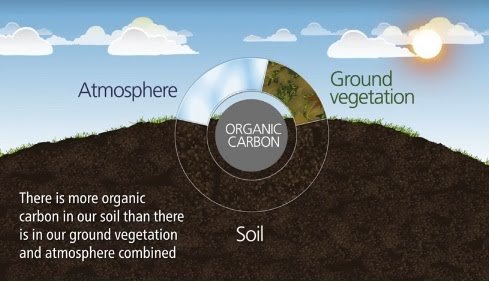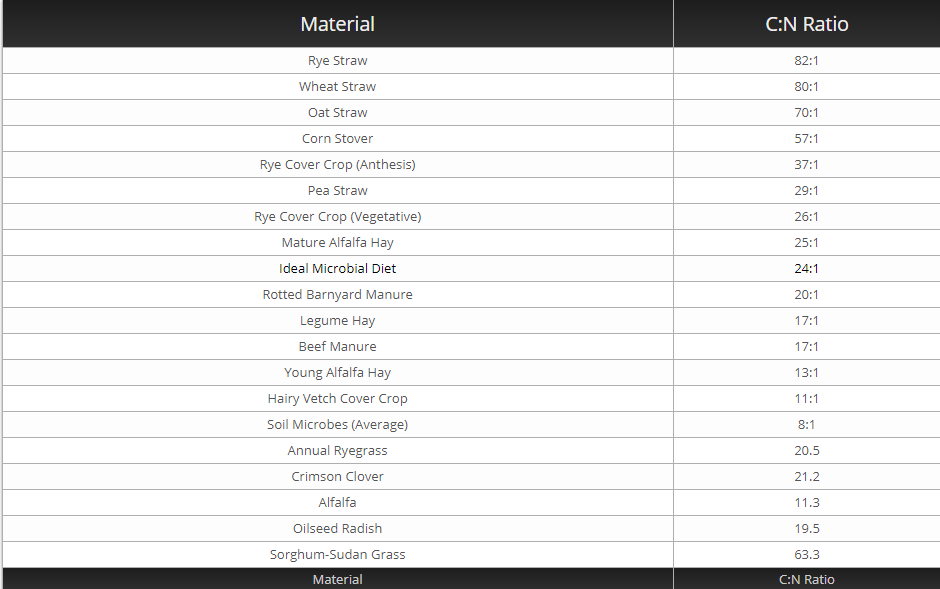Science For Growers: Understanding C:N Ratio And Its Role

For those, who skipped on reading, healthy soil always contains a certain percentage of organic matter (humus), which is an important carbon sink, and plays a fundamental role in nature.
The content of humus in soils worldwide varies greatly, from about 1% in desert soils to about 10% in forest floors, but most of the agricultural areas have about 3-5% of it. However, there are exceptions like sphagnum peat, which contains up to 87-94% of humus being THE MOST IMPORTANT carbon sink on this planet!
In total, humus holds about 1500 bln tonnes of organic carbon worldwide, which translates to about 5500 bln tonnes of CO2. This is more than double of what our atmosphere is holding at the moment, 740 bln tonnes of C with as much as 560 bln tonnes trapped in earth's biomass.
Humus is basically a non-specific polymer (a large type of a molecule composed of many repeated subunits) also defined as a colloid with typical C:N ratio of 10:1, but while it undergoes nitrification and ammonification with the help of nitrifying bacteria, the content of nitrogen goes up while carbon is consumed, so it needs to be constantly replaced like it happens in a balanced ecosystem!

What you need to know about humus as gardeners is that it:
- improves the structure/drainage of soil, and prevents its compaction
- increases trapping of light and heat due to its black colouration
- becomes a long-term source of food for fungi and bactera
- helps to establish strong microlife in soil
- binds permanently certain micronutrients such as aluminium, iron and sulphur, which are necessary for the plants
- takes care of nutrient recycling
- raises CEC of soil
- enhances water retention
Carbon to nitrogen ratio is an important measure of what's happening in soil! Basically, it's a number of units of carbon and nitrogen in every substance, needed to establish how long it's gonna take to break it down completely, and become humus.

Let's take wheat straw for example, which has C:N ratio of 80:1. This means it's heavy in carbon, but very light in nitrogen, so when left in the field after harvest, it's gonna lie around for ages before it decomposes, and becomes food for bacteria. In terms of human nutrition, it'd be like chewing a raw artichoke.
On the opposite end of spectrum we have vegetable scraps – the same that land daily in your compost bin – which have typical C:N ratio of 12:1. And this means they're gonna decompose very quickly as bacteria don't find a lot of carbon here, so they go through them like fire through a carton box. In human diet that'd be chocolate!
Is there a perfect one then? As soil scientists established by researching composting processes, we ought to shoot for 24:1 C:N ratio due to a couple of reasons. A typical soil microorganism has a C:N ratio of approximately 8:1, and in order to thrive and multiply it needs to consume 16 parts of carbon for energy and 8 parts for maintenance (keeping the cells together).
But why do we need to bother? Let's just imagine that our soil is heavy in woodchips, twigs, bark, coco coir or any similar carbon-rich material, cause we put it there for aeration or it accumulated naturally.
After a 4-6 weeks something goes wrong, and the plant starts showing nitrogen deficiency, and is wimpy overall. And this happens, cause nitrifying bacteria pulled out all available nitrogen from the soil to break down the carbon, and they need to break carbon down in order to divide cells and survive!
The conclusion is, the more carbon in soil, the more nitrogen it can accommodate, and vice versa.
However, this also works the other way. If we have too much nitrogen in soil – which is bad, especially for young plants, that use it to grow stems instead of root, which eventually leads to falling over and other problems – we can easily slow down its release by adding carbon-rich material. This is called immobilisation, and is a part of natural nitrogen cycle.
Optimally, as a good organic practise, we should be cooking or adjusting our soil to get 24:1 C:N ratio for controlled nitrogen release, perfect microbial population, right percentage of micronutrients available, and exemplary health of our plants!
Did you like it?
Follow, upvote, resteem
💚 💚 💚 💚 💚
Hmm, i wonder if i have this problem on some of my baby peppers. Great post. Those flowers are looking so frosty and delicious. Keep up the good work!
Yeah this is common with soilless mediums if you try to treat them like soil :) Outdoor or indoor?
Indoor at the moment, they're in a seed starter soil that i purchased which is think is high in peat but low in nutrients, very light soils so root can penetrate easy. But once it warms up ill be sending them outdoor. I've used coco coir but am looking at going with soil on going since it seems to require less upkeep.
Once you dial your organic soil in, it rarely cause any problems and when you recycle it the quality of flowers as well the general health of your plants actually get better!
You have a minor misspelling in the following sentence:
It should be accommodate instead of accomodate.Thx a lot :)
When I lived in Kentucky, i remember after the tobacco leaves where stripped my grandpa used to have my cousins throw the tobacco stalks on his yard. It made his grass so green!
Yep good practise leaving leftovers in the field.
Nice info. Handy to have nearby, I sometimes have sone trouble at the start of the grow, strong plant potting soil and a high ph in the water always cause some nitrogen problems. I know I should spent more time adjusting ph, but mostly everthing goes on a gut feeling.(always dank bud haha )Good tips!!
If you really have high PH a dash of compost tea will bring it down and will also neutralise chlorine if you wanna try an organic approach :)
Really scientific, im still trying to get my head around on this soil chemistry, I try to be intuitive makes it easier for me
Theory of soil is crucial if you want to understand what, how and why it's happening in soil. And once you harness this knowledge you open the door to better growing and not only weed or other specialty crops, but veggies and fruit as well.
I started this series, cause I felt, that cannabis growers didn't know enough about soil biochemistry, botany and microbiology, which frequently gave way to myths, inaccuracies and wrong gardening practise in general... but any gardener should find it useful.
id like to see all the information in a simple and clear table, then i think it would sink in better for me! atm im just using compost tea and composting the left over chunks from the tea. I also grow alfalfa as a green manure to put nitrogen in the soil.the soil look very fertile atm and my new seedlings have popped up pretty quickly. Think i must be doing ok so far!
You're doing well then :)
Unfortunately all this soil science is not as straightforward as we'd like it to be. Soil is a dynamic system with many variables, but there a few rules that both plants and microorganisms have to obey.... I could draw a list like that, but it's gonna involve a lot of reading anyway :)